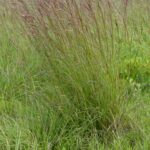big bluestem
Andropogon gerardii


Description:
Andropogon gerardii, also known as big bluestem, is a species of warm-season grass that is native to North America. It is a tall, upright grass that typically grows to heights of 4-8 feet (1.2-2.4 meters), though it can sometimes reach heights of up to 12 feet (3.7 meters) in ideal growing conditions.
The leaves of A. gerardii are long and narrow, and they are bluish-green in color. The stem of the grass is also bluish in color, and it is often covered with a waxy coating that gives it a bluish-gray appearance. The inflorescence of A. gerardii is a dense, branched cluster of spikelets that are often purplish or reddish in color.
Big bluestem is an important component of prairie and grassland ecosystems. In addition to its ecological importance, A. gerardii is also used for forage and hay production, and it has been cultivated as an ornamental plant in gardens and landscapes.
Details:
big bluestem
| USDA Symbol: | Common Name: | Scientific Name: |
|---|---|---|
| ANGE | big bluestem | Andropogon gerardii |
ITIS TSN: 40462
Category: Monocot
Taxonomy
Kingdom: Plantae
Subkingdom:
Super Division: Spermatophyta
Division: Magnoliophyta
Subdivision:
Class: Liliopsida
SubClass: Commelinidae
Order: Cyperales
Family: Poaceae
Counties: Adams, Barron, Bayfield, Brown, Buffalo, Burnett, Chippewa, Clark, Columbia, Crawford, Dane, Dodge, Door, Douglas, Eau Claire, Fond du Lac, Forest, Grant, Green, Green Lake, Iowa, Jackson, Jefferson, Juneau, Kenosha, La Crosse, Lafayette, Lincoln, Manitowoc, Marathon, Marinette, Marquette, Menominee, Milwaukee, Monroe, Oconto, Outagamie, Pepin, Pierce, Polk, Portage, Price, Racine, Richland, Rock, Rusk, Sauk, Sawyer, Shawano, Sheboygan, St. Croix, Taylor, Trempealeau, Vernon, Vilas, Walworth, Washburn, Washington, Waukesha, Waupaca, Waushara, Winnebago, Wood
| Duration: | Growth Habit: | Native Status: |
|---|---|---|
| Perennial | Graminoid | L48(N)CAN(N) |
| NR40 Listed Plant | Noxious Weed: | Invasive Species (NR40): | Threatened/Endangered: | WI Natural Heritage Index: | Wetland Status |
|---|---|---|---|---|---|
| FAC;FACU |
Carbon to Nitrogen Ratio:
Conspicuous Fall Color:
Conspicuous Flower:
Foliage Light Porosity Summer:
Height at Base Age (Max):
Height at Maturity: 6.5
Known Alelopath:
Re-sproutability:
Height (min): 36
Height (max): 108
Root Type:
Leaf Type:
Leaf Arrangement:
Leaf Shape:
Vein Pattern:
Adapted to Coarse Textured Soils:
Adapted to Medium Textured Soils:
Adapted to Fine Textured Soils:
Moisture Use: Low
pH (Minimum): 6.5
pH (Maximum): 7.5
Planting Density per Acre, Minimum:
Planting Density per Acre, Maximum:
Precipitation (Minimum): 12
Precipitation (Maximum): 30
Root Depth, Minimum (inches): 20
Temperature, Minimum (°F): -39
Plant Spacing (min):
Plant Spacing (max):
| Bloom Period: | Commercial Availability: | Fruit/Seed Abundance: |
|---|---|---|
| Fruit/Seed Period Begin: | Fruit/Seed Period End: | Fruit/Seed Persistence: |
|---|---|---|
| Propogated by Bare Root: | Propogated by Bulbs: | Propogated by Container: |
|---|---|---|
| Propogated by Corms: | Propogated by Cuttings: | Propogated by Seed: |
|---|---|---|
| Propogated by Sod: | Propogated by Sprigs: | Propogated by Tubers: |
|---|---|---|
| Seeds per Pound: | Seed Spread Rate: | Seedling Vigor: |
|---|---|---|
| 144240 |
| Small Grain: | Vegetative Spread Rate: | Propagation Treatment: |
|---|---|---|
| Days to Stratify: | Direct Sowing Time: |
|---|---|
Benefits:
| Berry/Nut/Seed Product: | Christmas Tree Product: | Fodder Product: |
|---|---|---|
| No | No | Yes |
| Fuelwood Product: | Lumber Product: | Naval Store Product: |
|---|---|---|
| -- | No | No |
| Nursery Stock Product: | Palatable Browse Animal: | Palatable Graze Animal: |
|---|---|---|
| No | Medium | High |
| Palatable Human: | Post Product: | Protein Potential: |
|---|---|---|
| No | No | Medium |
| Pulpwood Product: | Veneer Product: |
|---|---|
| No | No |
| Benefits: | Wildlife Food Value: | Wildlife Cover Value: |
|---|---|---|
References:
- iNatuarlist Database – Andropogon gerardii
- ITIS Database – Andropogon gerardii
- Native Plant Network Database – Andropogon gerardii
- USDA Plants Database – Andropogon gerardii
- WisFlora Database – Andropogon gerardii
Return to Native Plants page
